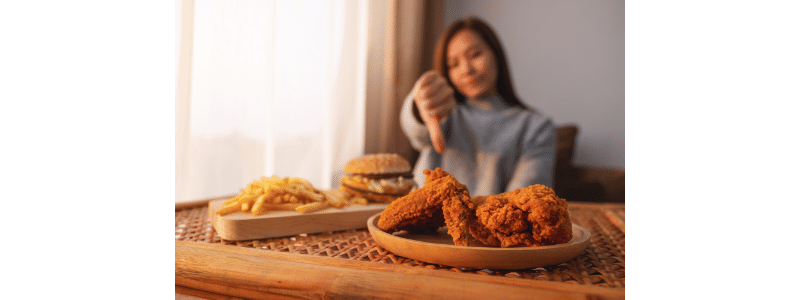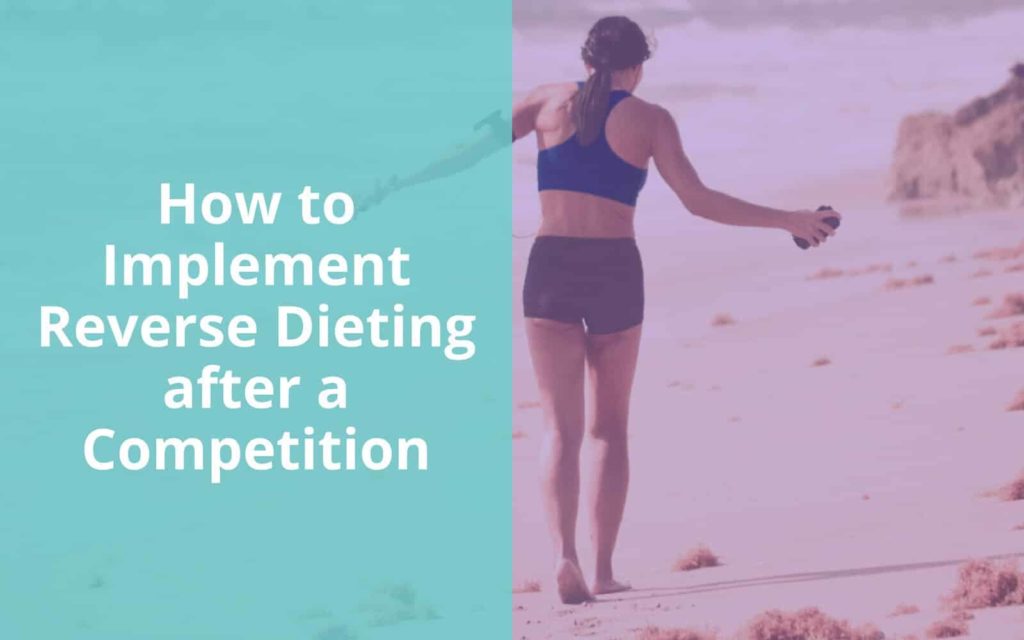You did it… You just spent several months to a year or more training your ass off (literally) day in, day out, telling yourself along the way someone out there is training harder and longer than me. I’ve got to keep going.
You practiced more discipline than you ever thought yourself capable of and worked on your stage walk and posing until you were doing it in your sleep.
You found the perfect suit- color, cut, fit and it looks… incredible on your sleek, toned, dieted-down body.
You obsessed over your tan and skin tone until you got it just right and you look amazing under those bright stage lights.
Your hair, makeup, nails and accessories are rockin’ and everything is in its place, just right, as planned.
And you just went through weeks and months of one of the most mind-bendingly difficult things you have ever done- dieting for your show.
Dieting Down

Ask pretty much any competitor and they will tell you that dieting for a show is the hardest part of the prep experience. You just don’t realize how hard it is to go without the things you really want and are used to having until you can’t have them. This part takes a crazy amount of discipline and focus.
Aside from eating super-clean and cutting out a whole plethora of yum-yums, the dieting process also involves (among other things):
- Counting your macros (carbs, proteins, fats) and calories
- Staying on top of your water intake
- Monitoring your weight and body fat percentage regularly
While the end-result is awesome, a body that you’ve likely never experienced before and are totally in love with, you’ve gotta ask yourself- is it realistic/ normal/ healthy to maintain this kind of dietary program?
After all that hard work it’s totally reasonable to not want to say goodbye to those hard-earned gains (and losses). In all honesty, it’s also not reasonable to maintain a competition-prep dietary regimen all of the time.
The other reality to consider is that dieting for a show can be pretty harsh, particularly toward the end of the shredding process in the weeks and days leading up to stage-readiness. Achieving an extreme drop in body fat oftentimes calls for what can feel like extreme measures when it comes to being strict with food choices and amounts.
It makes sense that a lot of athletes, especially first-time competitors, get in to an “F-it, I’ve earned this” mindset and want to go hog-wild on the carbs and calories post-show, right?
Unfortunately though, even after all the hard work and dieting, there can be consequences for post-competition pizza and beer (wine?) binges… as in a potential 10 to 20 pounds of weight gain and water-cankles. Not good. Or pretty.
The good news is that there is a way to continue to feel and be your best self while finding balance with your diet. Your hard-won progress doesn’t just go away but it does involve some continued intention and effort to find that middle ground.
After everything you just went through to get to this place, isn’t it worth it to continue to go the distance for yourself? It’s totally do-able!
Enter the concept of Reverse Dieting.
Put in super-simple terms, this is the process for bringing your metabolism back up to speed so that you can avoid gaining excess fat after having trimmed way, way down.
*Side note- This is not medical information or intended to provide a dietary plan! This article is meant to offer some general tips, information and things to keep in mind for post-competition diet. For a clear plan to follow for this process your best bet is to consult with a certified nutritionist & dietitian!
What is Reverse Dieting Anyway?
I had the pleasure and honor of chatting with one incredible woman, Heather Owens. Heather is a Certified Sports Nutrition Specialist, a Certified ISSA Personal Trainer, a Certified USA Weightlifting Sports Performance Coach, a nationally qualified Bikini competitor, a posing coach and the founder of Getfitgofigure.com.
Phew! This chick knows her stuff and was getting ready to do some public speaking on the topic of reverse dieting a few days after our chat. The info below is some of what she was kind enough to share with me.
Let’s start with some basics…
- Putting your body through the intense experience of dieting down for a show stresses your system.
- Once you’ve dieted down your metabolism has adapted to that stress by kicking in to “survival mode” and has slowed down.
- After you’ve restricted harshly to diet down for a show, if you just go back to eating the way you did before, or eating simply because you can (pass the cookies please) your metabolism won’t be able handle that.
- Weight gain can happen pretty quickly and dramatically. Because your body thinks it’s starving it’ll be really really good at soaking up all the junk you may be tempted to dump in to it, even if you’re not hungry.
Says Heather: “I’ve seen people gain like 20 pounds in 3 days.” Yikes.
How You Can Get Started
There are different ways to go about Reverse Dieting, and remember- this isn’t meant to be a specific plan to follow, but it is meant to give you an idea of what’s involved in this process. So check it out!…
Be Methodical
With this approach Heather describes cutting cardio down first which can look like cutting sessions in half for the first week, for example. Carbs are added to your diet methodically, and you see how things go by monitoring weight gain.
“Of course people gain weight, you have to gain weight. Within 10 pounds of stage weight is pretty good, 20 pounds is max if you want to maintain healthy, normal body fat levels for women. You just go from there as far as adding calories or taking out cardio and reversing that up as long as your weight is staying within a normal range.”
There a plenty of detailed guides and success stories about reverse dieting.
Do It Naturally
Our bodies will naturally tell us when we’re hungry and need food.
“If you listen to your body and eat when you’re hungry you will naturally Reverse Diet up to a normal body fat range” according to Heather. She also cautions- “if you started off with a higher set point, eventually you will get back to that higher set point if you don’t watch it.”
What’s a set point you ask? Good question.
Everyone has a set point for their body fat- a baseline or starting point that can be changed with work and dedication to a plan.
Someone starting off heavier, at say 30 to 40% body fat, can bring their body back to a normal body fat range with Reverse Dieting. If they’re not careful though, explains Heather, they may get back to that original set point if they’re eating a lot of processed or sugary foods or drinking excessively.
Eat Clean
Don’t count calories or macros and just eat clean!
Similar to a Paleo Diet, this approach involves leaving out grains. “It’s very easy to binge on bread and pasta” says Heather (amen sister), “it’s not cake but it’s still bread and pasta. Things that are very refined are easy to overeat, but it’s very hard to overeat an apple or broccoli.” Yup, heard that.
Since it’s pretty hard to overeat with this approach, sticking with meats, veggies, and root vegetables for your carbs (like potatoes and sweet potatoes) can be another route to take in the Reverse Dieting adventure.
Is Reverse Dieting Necessary?
It is, and it isn’t.
The whole point of Reverse Dieting is to not gain excess fat.
According to Heather Reverse Dieting gives people structure and guidelines so that they can avoid the easy-to-fall-in-to trap of going “off the rails and just eating because they can.”
On the other hand, Heather also points out that studies have shown that the metabolisms of people who have dieted down naturally recover to normal levels over time.
“Eat clean, no refined grains or sugars, and your body will naturally bring you back up to healthy levels again. Sleep and healthy foods are huge. Your body is very very efficient at healing itself when it’s given the right nutrients…
“So whether you actually do a reverse plan or not your metabolism will get back to normal… You may be fatter, you may not be.”
The take-away is that your metabolism will recover from being tanked post-show one way or another.
If you don’t follow some type of Reverse Diet, you risk gaining back more fat than you want and you may not be able to diet it off right away. It takes time for your body to normalize and repair any damage done from dieting down.
Is Reverse Dieting Right For You?
It really depends on you and your long-term goals.
What’s next for you? More competing? A baby perhaps? Normal life? (Whatever that is…)
Where you’re headed next, your personality, dieting history, lifestyle and stress levels can all play a role in what approach, if any, you should take to Reverse Dieting.
“Some people need a break” when it comes to counting macros and monitoring weight, points out Heather. So wise, so true.
If you’re planning on strapping on the ol’ stripper heels and hitting the stage again, then Reverse Dieting is definitely something you should consider. Why start all over when you can preserve your hard work and be that much closer to your goals the next time around?
The bottom line is that you need to make a clear decision on what feels right for you and go for it in a healthy, balanced way.
You will take your competition experience, including dieting and post-show dieting if that’s the route you choose to go, with you as you move forward in life. After putting in the time, work, determination, and commitment you can call on that same level of discipline to achieve any goal you set your mind to.
And the beauty part? You can do it with enjoyment and balance. It’s one of the sweetest parts of your hard-earned victory, and if you made it through the entire competition experience you are definitely a winner.

